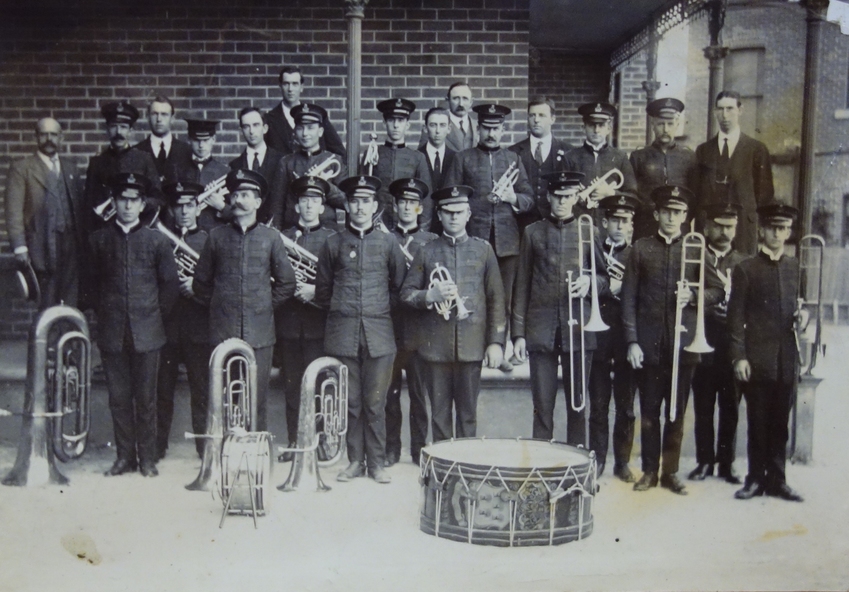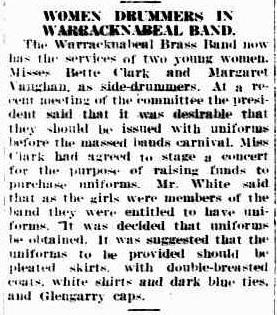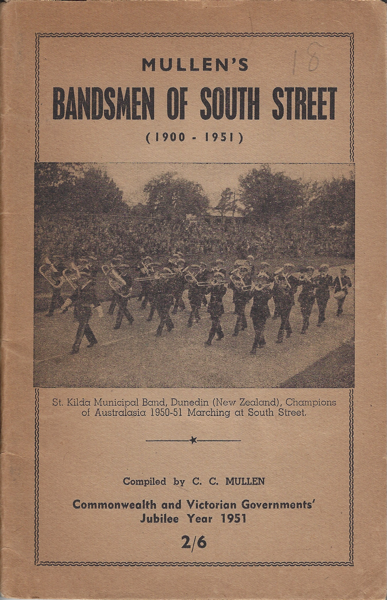Introduction:
Administering band associations was, and is even now, never an easy task. Granted, the first focus of early band associations was managing the affiliations of member bands, forming rules and running competitions. These tasks aside, there was little else they did. In this arcane and insular world of administration, decisions that the early band associations made were at times difficult to understand and criticism was rife. It can be seen in previous posts on the history of the National Band Council of Australia and the experiences of bands in South Street just how peculiar some administrative decisions could be. In their defence however, we can also see that the associations were acting on the information that they had available at the time, and that some questionable decisions can simply be attributed to a lack of communication.
This post is focusing on aspects of band administration where the difficult decisions of band grading and choices of music were made by sub-committees known as Music Advisory Boards. These noted groups of bands people, often adjudicators and conductors, made recommendations to band associations. While some records are not as informative as they could be, the Trove archive gives us some clues as to how they operated.
It is an interesting portion of band history where some bands people desired more of a focus on the music but recognized the value of association. Balancing these two ideals was a challenge!
Music Advisory Boards and Choosing music:


Above is part of the first page of an annual report presented by the Victorian Bands’ League at their second Annual General Meeting on 14th July 1933. Prominently displayed on this first page are all the officers of the League; Delegates, Administrators, Conductors and Adjudicators, representing country, regional and metropolitan areas. A good mix of people at the time to run the fledging League! There is one group of musicians listed on this page that warrants special mention and is nominally the focus of this post – the Music Advisory Board.
It was not always possible to discern why the Music Advisory Boards existed in the first place. Through research in the Trove archives, it was mentioned that they did exist, but their exact purpose in assisting the Associations was harder to find – however their contemporary counterparts operate in much the same way so we can apply this knowledge back over the years.
This post is not trying to dismiss the operations of other State band associations and their MAB’s. However, the Victorian Bands’ Association and Victorian Bands’ League provided the most information through newspaper articles as to who was included in their MAB’s over the years. Which means it presents a perfect case study of how the personnel changed (or did not change) over the years. Below is a table detailing the members of the Victorian MAB over a time period of thirteen years. Knowing Victorian band history, we can see that these musicians were all eminent conductors/adjudicators who displayed an extensive knowledge of brass band repertoire. And they were all conductors of Victorian A Grade bands.
| 1920 – VBL | 1922 – VBA | 1927 – VBA | 1933 – VBL |
| P. Code | J. Booth-Gore | P. Code | J. Bowden |
| P. Jones | L. Hoffman | F. C. Johnston | J. Booth-Gore |
| H. R. Shugg | F. C. Johnston | P. Jones | F. C. Johnston |
| P. Jones | R. McCaskill | A. H. Paxton | |
| H. Niven | H. R. Shugg | H. R. Shugg | |
| H. R. Shugg |

What is obvious here is the consistency of some of the appointments namely Percy Code, Percy Jones, Frank “Massa” Johnston, and Harry Shugg. Some pictures of these bandsmen are on the side of this post. We could assume that with the passage of time, if the same people were well-regarded in that role then they would continue to serve. The interesting fact about the Victorian MAB members is that they carried through the changeover from the VBA to the VBL. On a side note, given that many of these conductors were working with metropolitan bands at the time they would have been the instigators of the VBL in the early 1930s.
There were some occasions regarding band competitions where MAB’s were not involved in choosing music. We can see articles published in the Advocate newspaper in 1921 and 1927 that Percy Jones was the adjudicator of the popular New Year’s Day Burnie carnival band competition (“BURNIE.,” 1927; “BURNIE CARNIVAL.,” 1921). However, it is in the 1927 article where we can see that Percy Jones himself made recommendations to the Burnie Athletics Club on the choice of music for the next carnival band competition:
Last year’s band adjudicator, Mr. Percy Jones, wrote recommending that “Gournod (Rimmer)” and “A Garland of Classics (Rimmer)” be chosen as test pieces for the B and C grade contests respectively, at the next carnival. The recommendation was adopted, on the motion of Messers Southwell and Trethewey. It was also decided to continue negotiations with a view to obtaining an adjudicator from New South Wales for the next carnival. Last year’s rule that the own choice selection be made from National Airs was again adopted.”
(“BURNIE.,” 1927)
One notable criticism of the music choices made by MAB’s came from Cecil Clarence Mullen in his booklet, Mullen’s Bandsmen of South Street (1900-1951). We know from a previous post that Mullen was very opinionated, and it is not clear how much influence he wielded through his writings, especially his booklet. He wrote:
Some years ago the Advisory Board of selectors introduced a new type of Test Selection for South Street band contests. These are mostly technical works and appreciated by bandmasters and players, the musicianship point of view has only been taken into consideration. Our contests promoters and managers have been overlooked the fact that one party – the public who pay to attend contests – have been left out. Statistics show clearly that all the largest crowds at the South Street competitions were in the years from 1900 to 1924, when the operatic brass band arrangements were chosen for Test Selections. […] Technical works are all very well for those of us who understand them, but they are cold and colourless to the general listener as he cannot follow them and does not know what they are all about.
(Mullen, 1951, p. 6)

Now while Mullen might be right about the years when the largest crowds attended the brass band competitions at South Street, it must be recognized that he was merely expressing his opinion and it might be a short stretch to link crowd numbers with choices of music. He went on further in this section of the booklet to explain his reasons for wanting more operatic arrangements in the band competitions with the implied belief that they were far more musical than what current brass band composers were providing, and that they were more pleasing to the ears of the audience (Mullen, 1951). He was especially taken with the operatic arrangements of Alexander Owen and he also wanted a sight-reading section to be introduced (Mullen, 1951). This was not the first time Mullen wrote with favour on operatic works being played by bands. In a later article he attributed the fine playing of bands in the early years to their playing of operatic works (Mullen, 1965).
Aside from Mullen, there appears to be a distinct lack of criticism in early newspapers regarding the choices of music made by the MAB’s. Which contrasts with the criticisms levelled at State Band Associations and MAB’s regarding grading of bands. Grading was a vexed issue, and this will be explored in the next section.
Music Advisory Boards, State band Associations and Grading:
To understand why grading does or does not work, it’s important to know a little history on how Associations applied grading to bands. The first competition that included grading of some sort was in New South Wales at the 1896 Intercolonial Band Contest held in Sydney in November where bands were grouped into “first division” or “second division” (Greaves, 1996, p. 23). In Victoria, the first five years of South Street from 1900-1905 were ungraded and, Mullen (1951) has provided some history as to how grading developed from 1905.
In 1905 the first “B” grade contest was arranged owing to some bands having progressed so much from the experience and tuition of former English bandmasters that it was thought younger combinations and country bands would have a better chance in a second class contest. So fast did the better class bands progress, however, that it was thought that with many new bands starting that a “C” grade was held in 1909.
(p. 7)
Having only three grades was the status quo in Victoria until, according to available resources, a D grade was introduced in 1922 (“Victorian Bands’ Association,” 1922).

Let us take a look at how bands moved up or down grades over some years. Below are links to files that show the grades in certain years from Victoria, Queensland and Western Australia. The Victorian dataset is more condensed as they show the grades in the years 1920, 1922, 1923, 1924, 1926 & 1927. For Queensland, the dataset is more spread due to limited information and the files are based on information from the years 1913, 1919 & 1937. Included is an example of grading presented by the Western Australian Band Association in 1932, which is very limited, however there’s an interesting discussion from the WABA meeting that took place that year. All band lists were obtained from newspaper articles held in the Trove archive and can be accessed from the links in the citations. The grade files will appear as PDF’s and can be downloaded.
Victorian Grades – 1920-1927:
- Victorian Bands’ Association – A Grade Bands 1920-1927
- Victorian Bands’ Association – B Grade Bands 1920-1927
- Victorian Bands’ Association – C Grade Bands 1920-1927
- Victorian Bands’ Association – D Grade Bands (1920)-1927
(Source of Victorian grade data: “BAND ASSOCIATION,” 1923; “BRASS BANDS REGRADED.,” 1927; “CLASSIFICATION OF BANDS.,” 1926; “VICTORIAN BAND ASSOCIATION,” 1924; “VICTORIAN BAND ASSOCIATION,” 1920; “Victorian Bands’ Association,” 1922)
Queensland Grades – 1913, 1919 & 1937:
- Queensland Band Association – A Grade Bands 1913, 1919 & 1937
- Queensland Band Association – B Grade Bands 1913, 1919 & 1937
- Queensland Band Association – C Grade Bands 1913, 1919 & 1937
- Queensland Band Association – D Grade/Other Grades 1937
(Source of Queensland grade data: “Band Association.,” 1919; “GRADING THE BANDS.,” 1913; “NEW GRADING LIST,” 1937)
Western Australian Grades – 1932:
(Source of Western Australian grade data: Delegate, 1932)
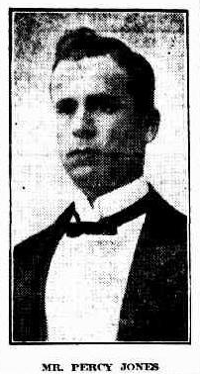
The Victorian context is possibly a better example of grade history given the range of years. Here we see a bulge– a smaller number of bands in A Grade and D Grade while B Grade is larger and C Grade having the most numerous amount of bands Taking a look at the C Grade in particular, while the D Grade was introduced in 1922, in 1924 there is large expansion of bands in C Grade. Whether this is down to the number of bands that affiliated that year, or general musical standard is open to interpretation. 1924 was certainly a golden year of bands, except for perhaps the A Grade where there were only three bands. Regarding the A Grade, once the top bands were placed in that grade, they tended not to leave. In 1926 and 1927 we see a jump in that number due to bands moving up from B Grade.
In Queensland it is a little more difficult to interpret the grading history given the lack of information, so a reliance on the available years is necessary. However, there are some similarities with Victoria, especially in the middle grades. In 1919 there is a large expansion in the number of bands in C Grade. We also see some innovation on the part of the Queensland Band Association in 1937 where there is a D Grade, but there are also grades to cater bands that are from specific locations or age groups. Here we see a “Sub D Grade (Country)” and a “Boy’s Band (Under 15 years)” (“NEW GRADING LIST,” 1937) which no doubt helped more bands participate in events.
The example from Western Australia is obviously small, but the list originates from an article published in the Sunday Times regarding a wide-ranging meeting held by WABA. The regrading of bands was included in the discussion as an agenda item:
The matter of regrading the bands affiliated with the association was then proceeded with. There are 17 in all, and prior to the 1931 contest these were graded as B or C. This grading has since remained unaltered officially, but for the purpose of giving the 1931 contest a high “tone”, the grades were officially announced as A and B. The question raised on Wednesday evening was whether to create a D grade from the smaller C grade bands or raise the status generally and make them A, B or C. The latter course was eventually decided upon and each band was, after submission to the meeting, graded by a majority vote. A suggestion that they should be graded according to the points awarded them by the adjudicator at the last contest was not accepted, though the idea found a good deal of support.
(Delegate, 1932)
Victoria offers more information on the roles of the MAB in the regrading process as the Queensland Band Association seems to have undertook this role themselves (there is no mention of a Queensland MAB). The role of the MAB’s in advising on regrading is evident although it seems, at least in the early stages, that the V.B.A. undertook the regrading process with their MAB offering limited advice. We see in 1920 that,
A report was submitted from the executive of the association dealing with the regrading of bands. It contained replies from Messrs H. Shugg and P. Code, two of the advisory committee who both concurred in the proposed regarding as submitted by the executive…
(“VICTORIAN BAND ASSOCIATION,” 1920)
However, in 1922, the Victorian MAB was responsible for the regrading process:
The advisory board of the Victorian Bands’ Association, the headquarters of which are at Ballarat, has regraded bands for the ensuring year as follows…
(“Victorian Bands’ Association,” 1922)
And mention of the role of the MAB in regrading bands is again mentioned in articles from 1926 and 1927 (“BRASS BANDS REGRADED.,” 1927; “CLASSIFICATION OF BANDS.,” 1926).
This is not to say grading was always a smooth process and there were always levels of criticism from various parties, as well as disagreements between States – the rules were never fully unified. As early as 1914 we can see letters in the papers regarding the grading of bands. One letter from Mr S. E. Hambleton, then Secretary of the Collingwood Citizens’ Band stood out for its candidness. Part of his letter was criticism while contributing his own ideas:
The band of which I am secretary has not won a cash prize for five years, and although I have made applications to be re-classified (claimed on two years’ rules), I am told that the Victorian Band Association would not listen to it as we are an A Grade band. The other bands know this, and, of course, will not enter for the higher grade, with the promise, perhaps of a life sentence hanging over them.
Our band of 24 could be divided into three parts and absorbed by B Grade bands and allowed to play in B Grade. Why not classify the individual players and thus stop good players in A Grade bands from becoming members of a lower grade through better inducements. Collingwood and Prahran are the only two bands classed as A Grade, although there are four or five others advanced enough to compete in this grade.
Bands that have won C or B Grade contests should be placed in the class higher up and stay there for the stated time. If they fail to secure a cash prize, allow them to go to the next grade down again. Bands will not enter for a higher grade than they are classed in, for fear of winning a cash prize in it, being thereby debarred from competing in the grade that they had been classed in.
(Hambleton, 1914)
Again in 1914, a letter was published in Brisbane’s Daily Standard newspaper lamenting the grading process carried out by the Queensland Band Association after the Maryborough contests. The writer, Mr W. Jackson, a Delegate of the Childers band, was obviously annoyed at the whole process and made this quite clear in his letter. He wrote (in part),
…We were promised that the matter of grading the bands would be thoroughly gone into at an early date by the Q.B. Association. What is the result? Here we are three months before the August contest, and still in the same sorry plight. Is it encouragement for the small country bands to go to Brisbane to contest against bands from the large cities as at Maryborough when the “C” grade championships was won by a band that probably should have been graded “B” at least? I am afraid the same thing will occur again. What I contend is that the “C” grade should be open for bands from the small country towns only, thus giving them some encouragement for them to fight on to better class music.
(Jackson, 1914)
It would be fair to say that both Mr Hambleton and Mr Jackson made some fair points re grading problems in their respective states. They both knew their bands and how the administration worked. We could assume that the State associations were trying their best in trying to please everyone but in some respects, it was never a perfect process. Perhaps this was the reason MAB’s were formed to advise on grading.
As mentioned above, at times the rules and administration of different State associations came into conflict with each other regarding registration and grading. One notable example was highlighted in Tasmania after another one of the contests in Burnie. At a meeting of the Tasmanian Band Association in 1930, this was raised as an agenda item:
Very grave concern was expressed by the committee relating to the methods of grading and the registering of members of mainland bands which compete at the Burnie contests. It was discovered by the delegates at the recent Burnie contests that one of the competing bands from the mainland had been able, only a few days before the closing date of registrations, to register no less than nine prominent players of other bands, and perhaps of a higher grade. The regrading of bands on the registration for every contest might overcome the somewhat unfair aspect of this matter, but what is more desirable is uniform contests rules for all the States. The T.B.A. is approaching the State association concerned on this occasion, with a view to a general tightening up of grading and registrations.
(“BAND ASSOCIATION,” 1930)
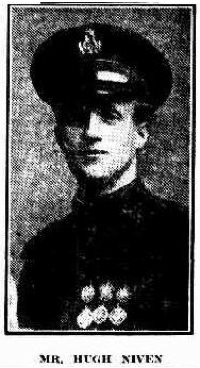
…which is fine in theory but as discovered in the history of the National Band Council of Australia, unification of rules was an ideal that never really reached fruition despite the best intentions of State associations.
What we have seen in this small history are situations where the grading process was fraught with difficulty, did not please everyone and criticism was rife. And it was a thankless task as the reputations of the early bands hinged on success in competition and the decisions of the State associations. Most of the time it was done correctly. On occasion there were problems. With the influx of bands starting up and wanting to participate in events, grading them was a necessity that called upon the State associations to try to find solutions. When this went wrong, the administration was generally found to be lacking.
Conclusion:
For the MAB’s involved in the processes of choosing music and advising on band regrading, generally they did the right thing and all they could really do was offer advice. Thankfully, the reputations of the MAB members carried them through some of the decisions made by State associations. Evidently the fact that many of the Victorian members held their positions for many years is a testament to their authority as prominent bandsmen.
We should thank these early members of the MAB’s for the foundations that they laid as the members of the modern MAB’s carry out their tasks in much the same way as they did back then.

References:
BAND ADJUDICATOR : For Newcastle Contest : Mr. Percy Jone’s Career. (1920, 04 December). Newcastle Sun (NSW : 1918 – 1954), 2. http://nla.gov.au/nla.news-article162621130
BAND ASSOCIATION : Deciding Championship. (1923, 21 August). Ballarat Star (Vic. : 1865 – 1924), 2. http://nla.gov.au/nla.news-article213824101
Band Association : Grading for the Contest. (1919, 20 November). Telegraph (Brisbane, Qld. : 1872 – 1947), 8. http://nla.gov.au/nla.news-article176840373
BAND ASSOCIATION : Registering and Grading. (1930, 24 January). Mercury (Hobart, Tas. : 1860 – 1954), 3. http://nla.gov.au/nla.news-article29151289
BRASS BANDS REGRADED. (1927, 18 October). Argus (Melbourne, Vic. : 1848 – 1957), 13. http://nla.gov.au/nla.news-article3885887
BURNIE. (1927, 17 June). Advocate (Burnie, Tas. : 1890 – 1954), 4. http://nla.gov.au/nla.news-article68241846
BURNIE CARNIVAL : New Years Day : Bright Prospects. (1921, 16 November). Advocate (Burnie, Tas. : 1890 – 1954), 4. http://nla.gov.au/nla.news-article69316043
CLASSIFICATION OF BANDS. (1926, 18 May). Argus (Melbourne, Vic. : 1848 – 1957), 8. http://nla.gov.au/nla.news-article3782670
Delegate. (1932, 21 August). BRASS BANDS : W.A. Association News : And General Notes. Sunday Times (Perth, WA : 1902 – 1954), 6. http://nla.gov.au/nla.news-article58669392
Drummer Boy. (1922, 21 October). BANDS AND BANDSMEN. Northern Star (Lismore, NSW : 1876 – 1954), 11. http://nla.gov.au/nla.news-article93411340
GRADING THE BANDS. (1913, 27 October). Queensland Times (Ipswich, Qld. : 1909 – 1954), 4. http://nla.gov.au/nla.news-article118654062
Greaves, J. (1996). The great bands of Australia [sound recording] [2 sound discs (CD)]. Australia, Sound Heritage Association.
Hambleton, S. E. (1914, 13 January). EFFECT OF GRADING. Herald (Melbourne, Vic. : 1861 – 1954), 5. http://nla.gov.au/nla.news-article241657411
Jackson, W. (1914, 08 May). BAND GRADING : (To The Editor). Daily Standard (Brisbane, Qld. : 1912 – 1936), 3. http://nla.gov.au/nla.news-article178879778
Mullen, C. C. (1951). Mullen’s Bandsmen of South Street (1900-1951). Horticultural Press.
Mullen, C. C. (1965). Brass bands have played a prominent part in the history of Victoria. The Victorian Historical Magazine, XXXVI(1), 30-47.
NEW GRADING LIST ISSUED BY QUEENSLAND BAND ASSOCIATION. (1937, 12 November). Telegraph (Brisbane, Qld. : 1872 – 1947), 13. http://nla.gov.au/nla.news-article183521534
Quickstep. (1920a, 28 August). Bandsmen’s Gossip : A Knight of the Baton. Herald (Melbourne, Vic. : 1861 – 1954), 19. http://nla.gov.au/nla.news-article242311544
Quickstep. (1920b, 14 August). Bandsmen’s Gossip : A Meritorious Career. Herald (Melbourne, Vic. : 1861 – 1954), 16. http://nla.gov.au/nla.news-article242305795
Quickstep. (1920c, 07 August). Bandsmen’s Gossip : An Enthusiastic Conductor. Herald (Melbourne, Vic. : 1861 – 1954), 17. http://nla.gov.au/nla.news-article242306287
Quickstep. (1920d, 11 September). Bandsmen’s Gossip : Australia’s Great Soloist. Herald (Melbourne, Vic. : 1861 – 1954), 14. http://nla.gov.au/nla.news-article242308980
Quickstep. (1920e, 24 July). Bandsmen’s Gossip : Leader of Two Famous Bands. Herald (Melbourne, Vic. : 1861 – 1954), 11. http://nla.gov.au/nla.news-article242308343
Quickstep. (1921a, 19 February). Bandsmen’s Gossip : Noted Musical Qualities. Herald (Melbourne, Vic. : 1861 – 1954), 16. http://nla.gov.au/nla.news-article242256082
Quickstep. (1921b, 08 January). Bandsmen’s Gossip : St Vincent’s Bandmaster. Herald (Melbourne, Vic. : 1861 – 1954), 11. http://nla.gov.au/nla.news-article242259553
VICTORIAN BAND ASSOCIATION : Classification of Bands. (1924, 19 August). Ballarat Star (Vic. : 1865 – 1924), 1. http://nla.gov.au/nla.news-article213535974
VICTORIAN BAND ASSOCIATION : Special and General Meeting. (1920, 18 May). Ballarat Star (Vic. : 1865 – 1924), 2. http://nla.gov.au/nla.news-article211906214
Victorian Bands’ Association : Grading for the Year. (1922, 24 August). Age (Melbourne, Vic. : 1854 – 1954), 14. http://nla.gov.au/nla.news-article205773169
Victorian Bands’ League. (1933). Victorian Bands’ League : Annual General Meeting : Annual Report [Annual Report]. Victorian Bands’ League. https://victoriancollections.net.au/items/5b6a740621ea691478e4b482


